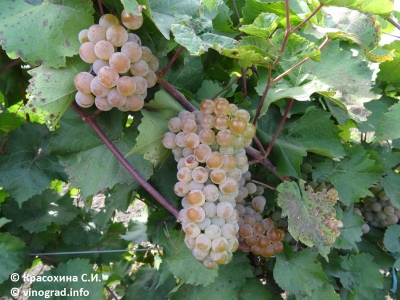
- Authors: Ukraine, NIViV "Magarach"
- Appointment: technical
- Berry color: white, turning pink when overripe
- Taste: pleasant, harmonious
- Ripening period: early middle
- Ripening period, days: 130
- Frost resistance, ° C: -25
- Name synonyms: Magarach 124-66-14
- Bunch weight, g: 160
- Yield: 120-140 c / ha
Magarach's gift is a technical variety that does not differ in an amazing and sweet taste of fruits, but gives gardeners the opportunity to produce incredibly tasty wine drinks. It is easy to grow and with proper care, the crop will produce a bountiful harvest.
Breeding history
The variety was bred in Ukraine, in NIViV "Magarach" (thanks to which it got its name). It also has another name - Magarach 124-66-14. This grape appeared due to the crossing of the varieties Rkatsiteli and Magarach 2-57-72 (Mtsvane Kakheti x Sochi black).
Geography of distribution
Ideal growing areas are:
Russia;
Ukraine;
Hungary;
Moldova;
Crimea.
Description
Ripening period
Bunches ripen on average for about 130 days. Ripening period is early-middle.
Bunches
The bunch is rather large, cylindrical-conical and not too dense. One weighs on average about 160 g. They are highly transportable.
Berries
Medium berries are round and white, turning pink when overripe. They have a thin, strong, but elastic skin and slightly slimy pulp, which spreads when fully ripe. One grape weighs about 1.8 g.
The fruits are actively used for the production of a variety of drinks, such as:
cognacs;
dessert and still white wines;
dietary juices.
Fresh berries are practically not consumed.
Taste
The fruits have a harmonious and pleasant taste.
Yield
The variety is high-yielding, about 120-140 kg / ha can be harvested from one bush. The fruiting factor is 1.5, there are about two bunches on one shoot.


Growing features
Technological varieties are extremely easy to grow, since they are not as capricious as table varieties. Despite this, the culture requires basic care. When growing a wine variety, it is necessary to ensure that the culture accumulates well the substances necessary to obtain a decent material for making wines.
Landing
Saplings should be planted in a well-lit area where they will be warm. The type of soil does not matter, but it will be better if the soil is loose and fertile enough. You can use soil that contains humus. If there is too much sand in the ground, it will not properly retain moisture. If the soil is too clayey, it will not allow water to pass through, which will contribute to rotting of the root system.
To eliminate the possibility of problems, it is worth thoroughly mixing the soil under the bush until the required consistency is achieved. It is also worth remembering about such a factor as the acid-base balance of the soil. If the soil is very acidic, lime must be added to it. If the earth is alkaline, potassium salts, sulfate or ammonium chloride are used.

Pollination
Thanks to the bisexual flowers, the plant is able to self-pollinate and does not require other pollinators to be found nearby.
Pruning
Timely pruning is essential for both table and technical varieties. The best option would be to trim 3-4 eyes with 45-50 eyes per bush.



Top dressing
As the crop grows, it should be fertilized using mineral and other fertilizers, which must be selected, taking into account the characteristics of the area and climatic conditions.
Frost resistance and the need for shelter
The variety is able to withstand low temperatures down to -25 degrees. Most often, the grapes are not sheltered for the winter, but the climate of the region in which the crop is grown should be taken into account. If the winter is mild, nothing threatens the Gift of the Magarach.

Diseases and pests
The plant is tolerant to mildew and root and leaf phylloxera (resistance 3 points). Despite this, it is recommended to protect the variety from various diseases and insects in order to keep the berries in decent quality. For this, special chemicals are used. Here are several prevention options for different problems.
To protect the culture from oidium, the following solution should be used: 90 g of colloidal sulfur must be dissolved in 20 liters of water.
So that the grapes are not attacked by the leafworm, the bushes and vines are cleaned of old bark in the spring, after which the plant is treated with a solution (10 g of copper sulfate, 50 g of colloidal sulfur per 10 liters of water).
In order not to be afraid of grape itch, it is recommended to treat the bush in the spring with a 2% solution of "Nitrafen".
To prevent the birds from feasting on the fruits, ratchets, nets and scarecrows are used.
Traps from bottles are saved from wasps, into which a mixture of sweet syrup and insecticide is placed.

If a grape is exposed to any disease or insect, this always affects its appearance.
Storage
Most often, the fruits are not stored, but if necessary, they can be stored for a while.











































































